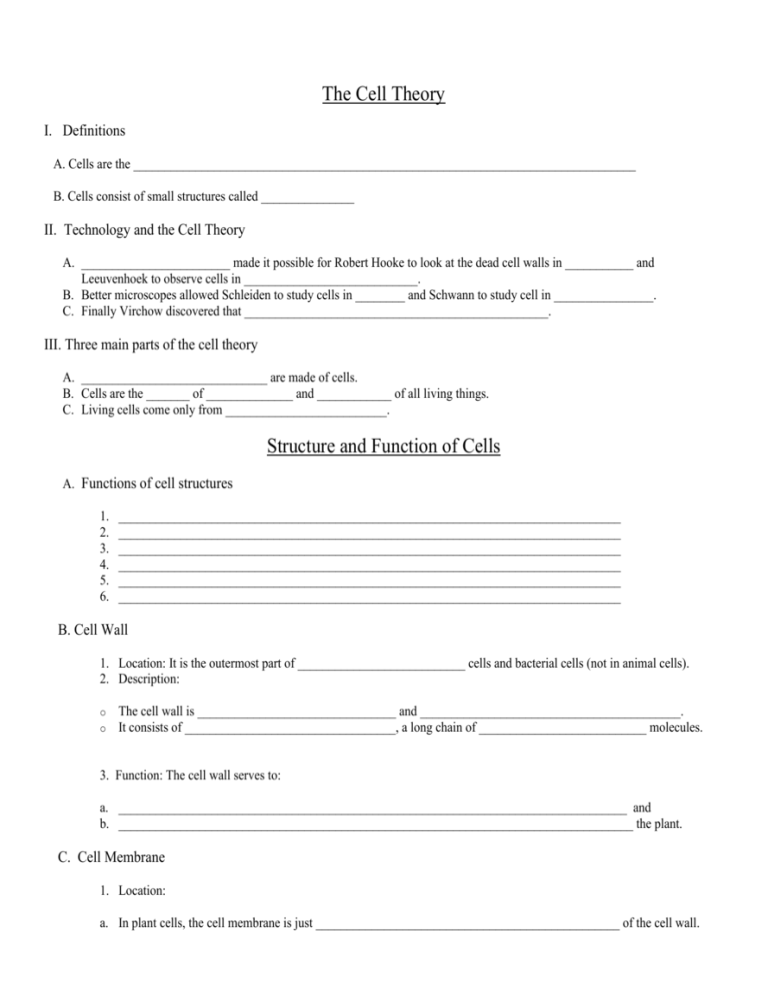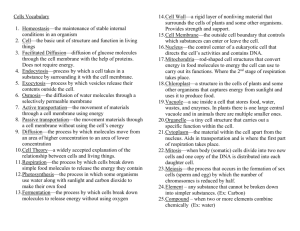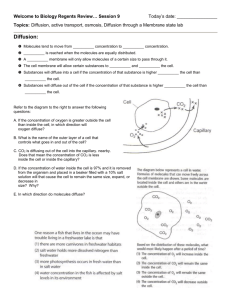A_Cells_Unit_Outline
advertisement

The Cell Theory I. Definitions A. Cells are the _________________________________________________________________________________ B. Cells consist of small structures called _______________ II. Technology and the Cell Theory A. ________________________ made it possible for Robert Hooke to look at the dead cell walls in ___________ and Leeuvenhoek to observe cells in ____________________________. B. Better microscopes allowed Schleiden to study cells in ________ and Schwann to study cell in ________________. C. Finally Virchow discovered that _________________________________________________. III. Three main parts of the cell theory A. ______________________________ are made of cells. B. Cells are the _______ of ______________ and ____________ of all living things. C. Living cells come only from __________________________. Structure and Function of Cells A. Functions of cell structures 1. 2. 3. 4. 5. 6. _________________________________________________________________________________ _________________________________________________________________________________ _________________________________________________________________________________ _________________________________________________________________________________ _________________________________________________________________________________ _________________________________________________________________________________ B. Cell Wall 1. Location: It is the outermost part of ___________________________ cells and bacterial cells (not in animal cells). 2. Description: o o The cell wall is ________________________________ and __________________________________________. It consists of __________________________________, a long chain of ___________________________ molecules. 3. Function: The cell wall serves to: a. __________________________________________________________________________________ and b. ___________________________________________________________________________________ the plant. C. Cell Membrane 1. Location: a. In plant cells, the cell membrane is just _________________________________________________ of the cell wall. b. In animal cells, the cell membrane is the _________________________________________________ of the cell. 1. Description: a. The cell membrane is strong but flexible. b. It has many small openings called __________________________________________________________. 1. Function: a. _____________________________________________________________________________________________ b. _____________________________________________________________________________________________ c. _____________________________________________________________________________________________ D. Nucleus 1. Function: a. Acts as the ___________________________________________________of the cell by directing all cell activities. b. Able to do this because of the _____________________________________________________ that contains all the information necessary to direct cell activities. 2. Description: a. Nuclear membrane: Surrounds the _______________________________ and has many small _________________ called pores that control what _________________________ and ____________________________ of the nucleus. b. Chromosomes: 1. Appearance: _______________________________________________________________________ 2. Functions: to _________________________________________ all cell activities and to __________________ the traits of the cell to new cells. 3. Composition: Made of large complex molecules called ________________________________. These molecules store the ________________________________ to make all the ____________________________ that are needed run the cell. Proteins are needed to make cell structures and for the _______________________ and ______________________________ that control cell activities. Two kinds of nucleic acids are _________________________________ and _______________________________________. The DNA is the stays in the ______________________________________________ and is the real control centre of all activities. a. Nucleolus: the site of _________________________________________________________________ E. Endoplasmic Reticulum 1. Location: in the __________________________________________ (the clear, thick jellylike substance between the ________________________________________ and the ______________________________________________) 2. Description: Clear, tubular ____________________________________________________ leading from the nuclear membrane. Some lead to the ____________________________________________while others to other areas of the ____________________________________________________________________. 3. Function: A ______________________________________________ system to carry ________________________ from one part of the cell to another or through the _____________________________________ and out of the cell. F. Ribosomes 1. Location: Attached to the ______________________________________________ surface of the ______________ ___________________________ Description: _______________________________________ bodies composed mainly of a nucleic acid, ____________________________________________________________________________. 2. Function: to ________________________________________________________________________________ G. Mitochondria 1. Location: In the ____________________________________________________________________ of the cell. 2. Description: Larger than ___________________________and ____________________________shaped with a __________________ membrane. They also have a small amount of their own ___________________________. 3. Function: Called the ___________________________ , inside the mitochondria _____________________________ are broken down into ________________________________ and _______________________________.This process releases large amounts of _____________________________________________________________that the mitochondria stores in special energy-rich ____________________________________________________________. H. Vacuoles 1. Location: In the ________________________________________________________________ of the cell. 2. Description: Large, ______________________________________________________________sacs 3. Function: ___________________________ tanks for _________________________________, water, and _________________________________________________________. I. Lysosomes 1. Location: In the ________________________________ of the cell. Common in _____________________________ cells but not in _____________________________________________________________ cells. 2. Description: Small, ________________________________________________organelles filled with _____________ ________________________________________________ and surrounded by a membrane. 3. Function: They break down large ______________________________________________ molecules into smaller ones that are then passed on to the _________________________________________. They also _____________________ old _______________________________ so they can be used again to build new ______________________________. J. Chloroplasts 1. Location: In the ____________________________________ of ________________________________________ cells. 2. Description: Green, _________________________ organelles that contain ___________________________________. 3. Function: The _________________________________ captures the ________________________________ from the sun. It uses this energy in the process of ________________________________________________ to use carbon dioxide and water to produce ___________________________________________________ for the cell. Oxygen is also given off from this process. Cell Processes: Life processes carried out by the cell include __________________________________, _____________________________, ____________________________________________, ____________________________ and __________________________. A. Metabolism: The sum total of all the __________________________________________________ and __________________________________________________________ activities that occur in the cell. Importance: Cells must ___________________________________ energy from the ________________________________________________ and ____________________________________________________________into a form they can use through a series of ________________________________________________________________________ activities. B. Respiration: The process in which ______________________________________________________ (such as ______________________________________) are broken down to ________________________________________ energy. Importance: All ___________________________________________________ need a continuous supply of ____________________________________________________________________________ . Types of Respiration: Aerobic respiration: Food enters the _______________________________________where it is broken down when it combines with __________________________________________. The ____________________________________ that is released is stored in _____________________________________________, and energy-rich ____________________________________. The energy in the ___________________________________ can then be used by the cell to do __________________________ Anaerobic respiration (also called ___________________________________):Energy is ______________________________ and __________________________________________________ is produced without ______________________________. The amount of energy released in anaerobic respiration is __________________________________________________ than the amount released in aerobic respiration. One organism that uses fermentation is ____________________________________ and breaks down glucose to release carbon dioxide, ________________________________________________________ and alcohol. C. Diffusion: The process by which _______________________________________________ of a substance move from areas of higher ___________________________________________________ if that substance to _______________________________of ___________________________________________________concentration of that substance. Diffusion does not require energy. o Importance: This process drives the movement of many substances (such as food, __________, water and other materials) in and out of the cell through _________in the _____________________. If there are many __________ molecules outside the membrane, for example, some will _____________ through the ____________ into the cell. The cell membrane is ________________________, this means that it allows only certain molecules to diffuse into or out of the cell. D. Osmosis: The diffusion of water into or out of the cell. During osmosis, ______________________ move from a place of ____________________________________________ concentration to a place of _____________________________________________ concentration. Osmosis does not require energy to happen. o Importance: Osmosis keeps the cell from ________________________________________________. E. Active Transport: The cell uses some of its _____________________________________________ reserves to move substances into/or out of the ____________________________________________________ even if the cell membrane is not ___________________________________________________________________________ to these substances or the substances cannot simply ________________________________________________________________ through the membrane. Importance: The cell is able to get needed substances and to _____________________________ substances that cannot ______________________________________ through the ___________________________________________.








